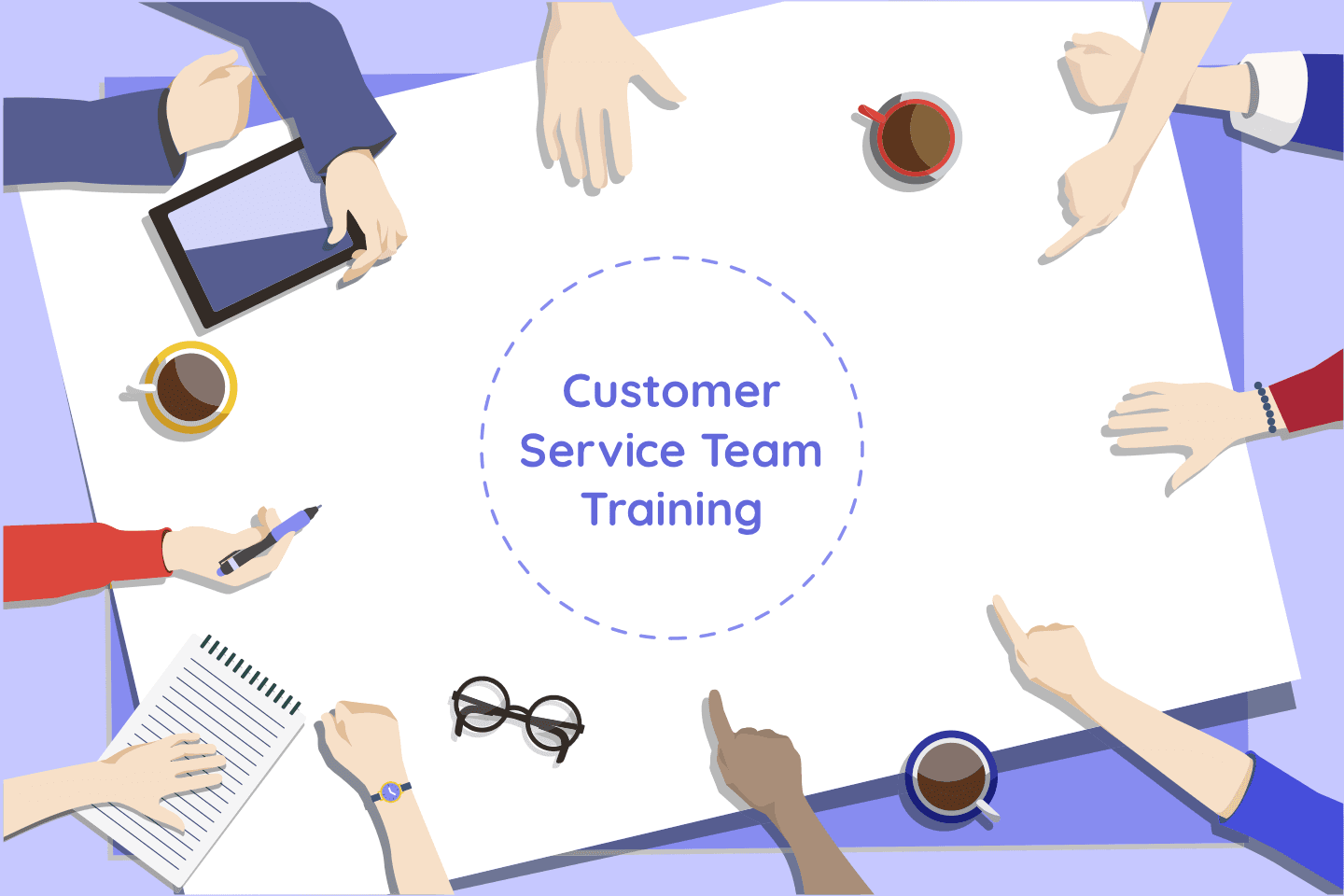According to a recent study, 80% of customers said that the experience a company provides is just as important as its products or services.
To ensure you are providing the best customer experience, you need to have a top-notch team. But even the best of teams can grow a little complacent or could use a little inspiration. That’s why we suggest leveraging fun games for your customer service training.
Below are three great games (and a few bonus ones) that you can introduce at your next team meeting.
Idea #1 – Can’t say NO to that
Purpose: To learn how to avoid saying “no”.
Goal: Answer all kinds of requests without actually turning them down
What you will need: A small group of people
Duration: A few minutes to prepare, then a few minutes per person

In customer service, you want to avoid saying “no”. When a customer calls to complain about something or has a request, they don’t want to hear that you can’t do something. The classic example is a business offering store credit when they can’t give a refund.
With this game, players will do everything they can to avoid turning down a request. To play this game, have your players sit in a circle. Give everyone a few minutes to think about a few requests or questions. These could be reasonable requests (“Can I have one of your pretzels?”) to something funny or outlandish (“Can I have your car?”).
Once everyone is ready and have their request ideas, have them make requests to a person sitting next to them. The goal is to avoid saying “no” to the person making the request. For example, if the first person requested their car, the second person could respond with “I can give you a ride home instead”.
Now the person who replied to the request get’s to ask their own question to somebody else repeating the process from the beginning. Everyone should get a chance to ask and reply to the request at least once.
This is a simple game that helps train your customer service reps to find new solutions and while avoiding to use the word “no” no matter how unreasonable or outlandish the request is. This practice is especially helpful for new businesses that need to establish customer relations quickly.
Idea #2 – Persuade me
Purpose: To learn how to deal with customer complaints
Goal: Convince a partner to complete a simple action
What you will need: A small group of people, split into pairs
Duration: Roughly 5 minutes per person

A good customer service representative has to be able to work with all kinds of customers. This game can help your representatives practice their different persuasion techniques since different tactics work on different types of people.
To start, split your group into pairs. Then within each pair, split them up into either Group A or Group B. Give Group A a simple task that they need to convince their partner in Group B to complete. Some examples include sitting down, standing up, putting on a jacket, turning around, or telling a joke. Give Group A around 5 minutes to try out their persuasion skills. After that, ask them to switch roles
Once both members of the pair have had a chance to try to persuade the other, bring everyone back into a large group and lead a discussion.
- What methods seemed to work for people?
- How can you form a connection with your customer?
- What methods didn’t work, and why didn’t they work?
Give yourself plenty of time for this discussion, as it can lead to some great insights. You may even find it helpful to repeat the exercise after the group discussion so your reps can practice what they learned.
Idea #3 – Remember my name
Purpose: To help your representatives better remember names
Goal: Remember the name of everyone within a group
What you will need: A group of around 10 people
Duration: 10 to 20 minutes

Customer service reps may deal with dozens of new people each day, and forgetting a name can quickly lead unsatisfying customer interaction. The goal of this game is to teach your live chat agents some strategies for remembering names, no matter how many new people they talk to in a day.
This game works best for groups of people who haven’t met yet, but you can alter it if your team is already well-acquainted.
The game is simple: everyone sits in a circle and they take turns introducing themselves. Each person will say their first name, then a short fact about themselves (“I like to read Science Fiction novels”). Give the rest of the group a few moments to memorize the information, and then move onto the next person. After everyone has introduced themselves, ask around the circle to see if anyone can remember names and facts about their colleagues.
The goal of this game is to introduce name-remembering techniques. There are several strategies that will help your team to remember names and information:
- Repetition: Repeat the information over and over again until it sticks
- Imagery: Create an image that you can associate with the person’s name. For example, if someone’s name is Jack, picture them doing jumping jacks.
- Rhyming: Rhyme the person’s name with another word. Mark is dark, Michelle fell, etc.
The idea is to not only remember the name and fact by heart but to practice associating information them with something specific, so they can easily remember.
Bonus idea #1 – One minute, please
Purpose: To build strong communication skills
Goal: To talk for one minute without interruptions or stalling
What you will need: A group of people split into two teams, something to keep score on, and some buzzers/whistles are optional.
Duration: 10-15 minutes

This is a fun game that can add some real energy into a room. The goal is to help your agents become more confident in their conversations. They can accomplish this by being able to speak for one straight minute on a given topic without stalling, pausing or any other interruptions.
Start by splitting the group up into two teams. Then pick one person to start off and assign them a topic of conversation. It can be something random (their favorite movie, the weather outside, etc) or about other lessons you learned that day. It’s then that person’s job to talk about that topic for one minute straight. They are not allowed to repeat themselves, deviate from the topic, or stall in any way (no “ums” or pauses).
If the other team catches that person making a mistake (deviating, repeating or stalling) they buzz in (either with a buzzer, raising their hand, yelling, etc) and asks for a “challenge”. Once a challenge is issued, you pause the timer until it is resolved. If the challenge is deemed correct (the person speaking did, in fact, stall, repeat, etc), the challenging team gets a point and a chance to take over remaining time on the clock. If the challenge is incorrect (the person speaking didn’t make a mistake), the speaker’s team gets a point and continues on.
After the minute is up you can assign a new topic and go again. Keep repeating this until everyone has had a chance to go at least once, then add up the points to see who won.
Bonus idea #2 – Chinese whispers
Purpose: To learn the importance of communication and speed
Goal: Pass a message from one member to another, without altering it
What you will need: A group of people
Duration: 5-10 minutes, depending on the size of the group

Chinese Whispers is a classic game that you can implement in your customer service training. The concept is pretty simple, and it’s likely you played it before, probably as a kid. Start off by getting the group to stand in a circle. Then you give one person a message, preferably something a little long and complicated. This person then whispers it to the person standing on their left, who then whispers it to the next person and so on.
The message keeps going around the circle until it ends up with the person standing to the original person’s right. The last person says the message out loud. The goal is to say the message from the first person correctly
To make this game more effective, there are two rules you’ll want to put in place. First, the person passing the message cannot whisper it more than once. Second, give the entire circle a time limit.
In customer service, you often have to work quickly, but this doesn’t mean your communication skills should suffer. Chinese Whispers is a fun and simple game that can demonstrate what happens when you try to rush or don’t communicate effectively.
A final word on the customer service training importance
Your CS team plays a large role in positioning your brand in customers’ minds. This is why it’s important that you give them regular training, but that doesn’t mean the training must be boring. Playing customer service training games every once in a while hone on your representative’s skills while adding some fun into the workday.




